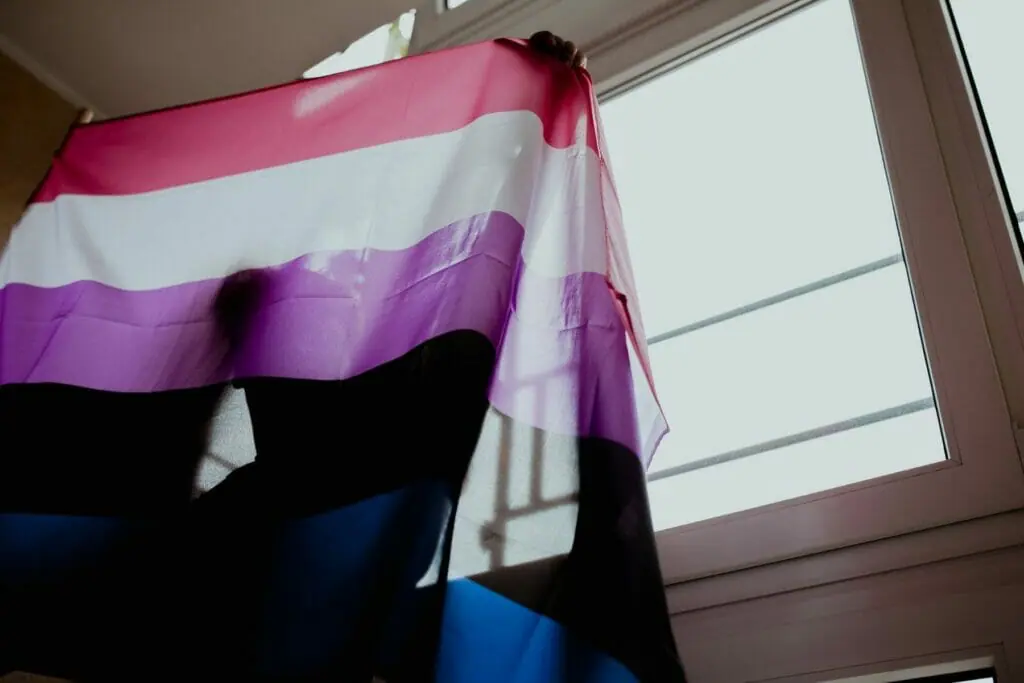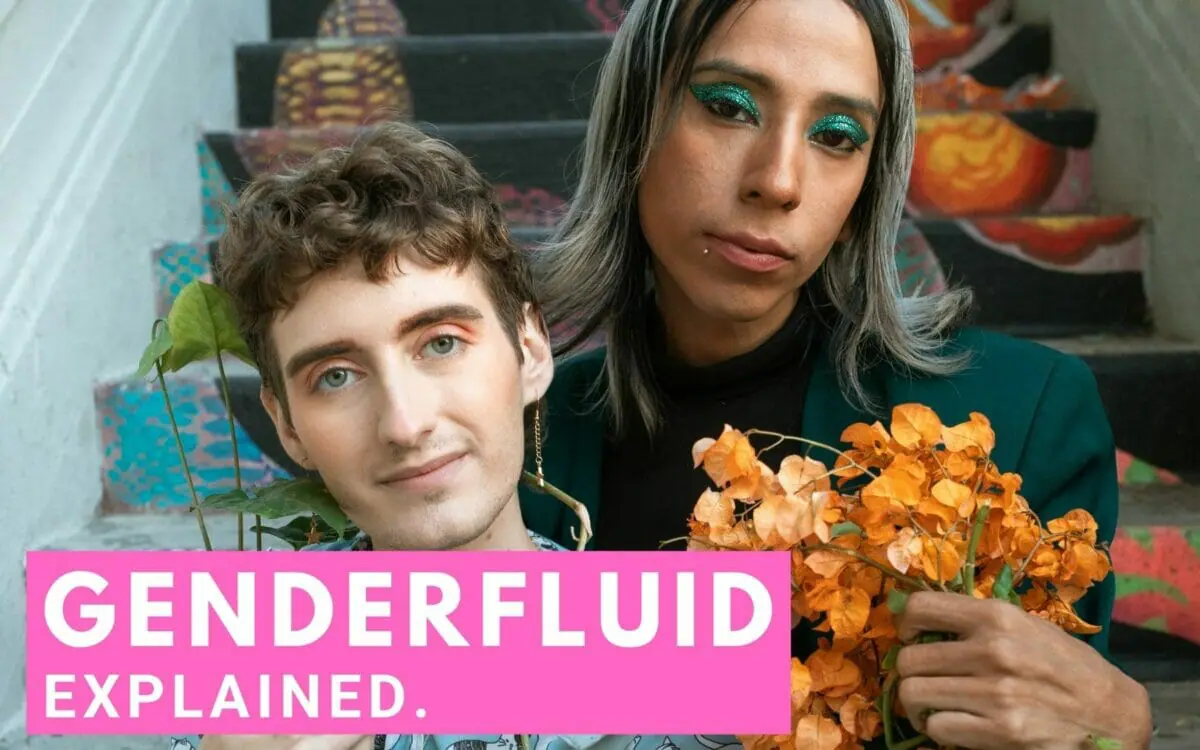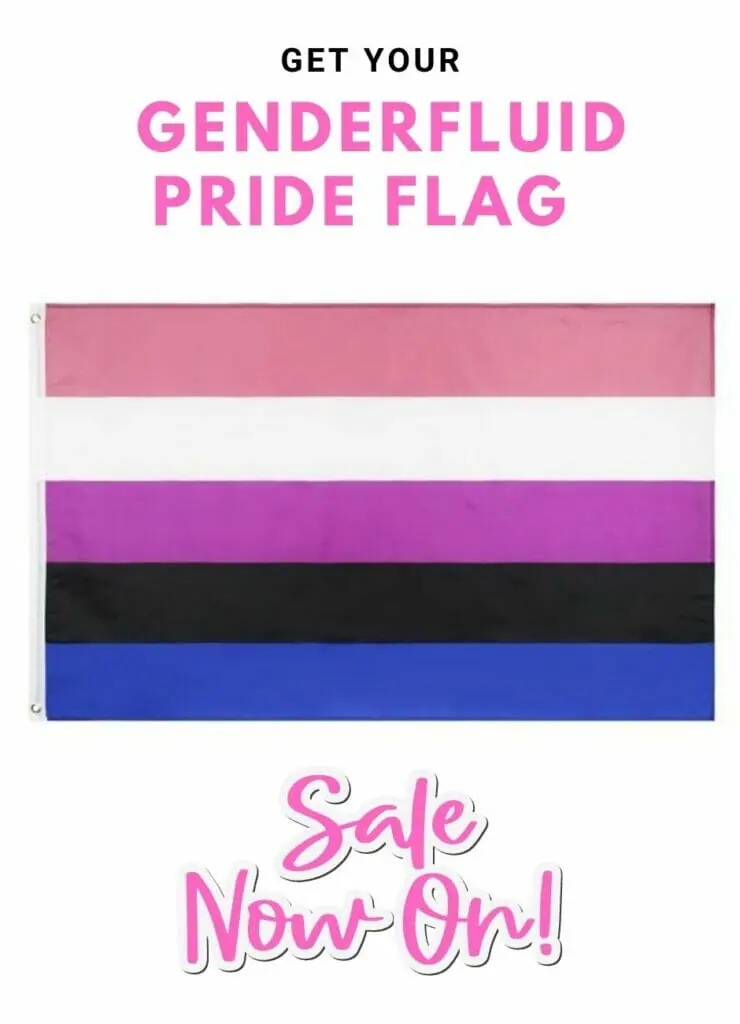There are many gender identities and sexual orientations that anyone can feel connected to or identify with.
More and more terms have been popularized over the years to represents the emotions and experiences of queer individuals and if you aren’t immersed in the LGBTQ+ culture or the queer community, you might not recognize a few sexual orientations and gender identities due to a lack of representation in mainstream media.
One such term is genderfluid. Sadly it is one of the more misunderstood gender identities, so we are going to talk about what does it mean to be genderfluid, discuss the gorgeous genderfluid pride flag, and help you with some information to become a better ally to the genderfluid community.

In this article we will cover...
What Does Genderfluid Mean?
For many people, gender is an aspect that is constant their whole life. However, for others, things aren’t this simple and their gender identity or expression may fluctuate their whole life. These are genderfluid people.
Genderfluid people experience gender fluctuations over time. For example, a genderfluid individual may identify as a man today and a woman tomorrow. It is also possible for genderfluid people to identify as bigender, agender, or a different non-binary identity.
For some genderfluid individuals, gender changes are arbitrary while for some they’re extreme. Gender fluctuations may happen slowly over a period of months or years or they may happen fast in a matter of hours or days.
When a genderfluid person experiences changes in their gender identity, they might change the gender expression. Some, however, might not change how they present themselves; the pronouns they use, or even how they dress.
Gender expression depends on an individual and they might not want to change how they look outwardly. To make sense of what the term genderfluid means, it’s vital to understand that gender isn’t as simple as society has tried to make us believe.

Gender identity is how an individual identifies. It could be as a woman, a man, or as something else. While we’ve been led to believe that woman and man are two different things, it’s important to understand that gender expression and gender identity exist along the same spectrum.
There are people that identify more with being female or male. Others may fall somewhere along these two sides. Other people may want to express themselves as more feminine, and others as more masculine. There are those who may switch between male and female identities or identify as something else somewhere along the spectrum like demiboy or demigirl individuals.
Genderfluid people can express themselves or present themselves in many different ways. An individual doesn’t have to adopt an androgynous look or act feminine or masculine for them to be considered genderfluid. They can however do this if this is what they feel comfortable doing.
There is also a difference between Genderfluid vs. Genderqueer and by understanding this difference you will be in a better position to define and answer what does genderfluid mean.

Genderfluid Pride Flag Meaning
Most queer identities have their own LGBTQ flag and genderfluid people are no exception. The Genderfluid Pride Flag was created in 2012 by JJ Poole. This flag has five horizontal stripes. They include:
- Pink for femininity
- Blue for masculinity
- Purple for femininity and masculinity,
- Black for lack of gender
- White for all genders
When is Genderfluid Pride Day?
Awareness, visibility, remembrance, and celebration are all important in increasing the acceptance and recognition of queer identities and queer folx around the world.
By observing an international day for genderfluidity, it is easier to for genderfluid individuals to talk to friends and loved ones – and to feel the love. It also helps foster awareness and increased sensitives from society at large.
So, mark your calendar and plan something special (even if it is just a social media post!) for April 6th, which is International Genderfluid Pride Day.
Other Genderfluid Information To Help You Be A Better Ally
Here’s what you need to know to be a straight ally to the genderfluid people in your life.
You shouldn’t argue with how one feels
Even though gender fluidity is a relatively new concept or topic, you cannot argue with how someone feels. If someone doesn’t feel or identify with being female or male, or they don’t want to limit themselves to societal expectations, you should accept it.
Whether or not you agree with gender fluidity, you should still respect someone who says they’re gender fluid. And if you don’t agree, well, you might want to question why that is and do some internal digging rather than projecting your issues onto others.

Clear your head
Even if you don’t acknowledge it, you most likely have biases and prejudices that you should confront. It might be uncomfortable for you to realize it at first, but once you realize what they are, you will be able to confront them.
Confronting your biases includes educating yourself about what being genderfluid is. Remember that the LGBTQ community no longer uses derogatory terms such as ‘homo’ or ‘homosexual’. Lesbians may prefer to use the term ‘gay’, ‘queer’, or ‘lesbian’ to describe themselves, and the most commonly used pronouns for genderqueer folx are ‘they/them/theirs.
Never, ever, ever refer to someone as “it” – because only a bad human would want to refer to another human in this way – regardless of gender. And you aren’t a bad human, are you?
Some people like to make crude comments or derogatory remarks and jokes towards gender-non-conforming folx. If you hear such remarks against your friend or other people in the queer community, speak up against such prejudices and let them know it isn’t right to encourage or take part in it.
The same goes for any jokes that are at others’ expense, especially queer marginalized communities and misunderstood identities such as intersex, asexual, transgender, demigirl, demiboy, and abrosexual. We are not here to be the butt of any jokes – and quite frankly, are sick of it. It is not – and never was – OK.
Most times, offensive material is circulated on social media or WhatsApp. Remember to tell people that are making such comments why it’s wrong to do that.
The use of pronouns
Gender fluid people may use different pronouns according to how they feel. For example, if they identify as male, they might use he/him pronouns. If they identify as female, they might use she/her pronouns. Others, may prefer to use gender-neutral pronouns such as they/them.
If you aren’t sure about someone’s preferred pronouns, always ask. Genderfluid people may use different pronouns than you are used to.
Don’t worry if you aren’t used to asking about someone’s preferred pronouns. You will soon get used to it. Just remember that using someone’s preferred pronouns is a way of showing respect for their identity and that there’s nothing wrong with it.
You can help normalize the use of pronouns in your everyday life with small actions like giving your preferred pronouns at the beginning of an introduction, signing your emails off with them, or wearing LBGT enamel pins that declare your pronouns to the world.

No one’s experience of gender is the same
Understand that experiences of gender are different and unique to each individual. When someone tells you about their experience with gender, listen to them and validate them.
No one can be an expert of someone else’s gender except the person who is experiencing it. As we mentioned earlier, some people may experience arbitrary changes in their gender identity and others may experience gradual changes.
In the same way, others may use gender-specific pronouns and others may use gender-neutral pronouns.
Be Patient
Be patient if some one love is experiencing changes or fluctuations in their gender identity. For some youth, gender fluidity may be a way of exploring their identity on the way to a more ‘stable’ identity. However, for others, that is how they will live for the rest of their lives.
When a loved one tells you about their changing gender identity, be patient with them even though it might be confusing for you. This is who they are and they might also be getting used to being this way.

Not everyone gets gender-affirming surgery
Some genderfluid people choose to get gender-affirming treatments such as surgery or hormone therapy. But, not all of them do. Gender-affirmation treatments are a way for someone to align their outward expression or physical bodies with how they feel.
However, not all genderfluid people choose or are comfortable doing it. If your loved one says they don’t want to do it, that’s all there is to it and it doesn’t mean that it’s your cue to question who they say they are. If a loved one says they want to get gender-affirming surgery or treatments, support them to make informed decisions.
This may look like linking them up with online resources, books, or healthcare practitioners that will help to answer all the questions they have about their treatment. Connect them to individuals they can relate with so they can interact with people who have had similar experiences.
It’s not a phase
Even though genderfluid people may experience fluctuations in their gender identity, that doesn’t mean they’re in a ‘phase’. The nature of gender fluidity is that the person experiences changes in their identity. Changes means the person is experiencing their identity as it is.
Not that they’re no longer genderfluid or now identify as something else. Only an individual can decide whether or not they are genderfluid and no one can do it for them.

How To Help Your Loved Ones Understand Your Genderfluidity
Explaining to your loved ones that you’re gender fluid isn’t an easy thing. Nevertheless, you can do it as long as they keep an open mind and are patient throughout the process.
Here’s what you can do to help them understand your gender identity:
- Encourage them to listen to what you have to say first and then ask questions free of judgement.
- Tell them that being gender fluidity isn’t a way for you to express femininity or masculinity, rather, it’s an avenue for you to express your emotional and physical interactions with the world.
- Provide information for them to understand that you aren’t experiencing a mental illness or hoping onto a trend.
- Talk about your emotions, thoughts, and feelings in an honest way. Don’t try to manipulate your family into accepting you. Let them understand what being genderfluid means to you.
Sometimes, even when you try to make the see who you really are, the closest people in your life such as your family and friends may not understand or accept what you’re trying to say. Now is the time to be patient with them and give them as much space and time as they need.
If you’ve given them sufficient time and resources yet there isn’t any progress, you can ask a counselor or people you trust who have been in the same situation to help you come up with a new plan.





